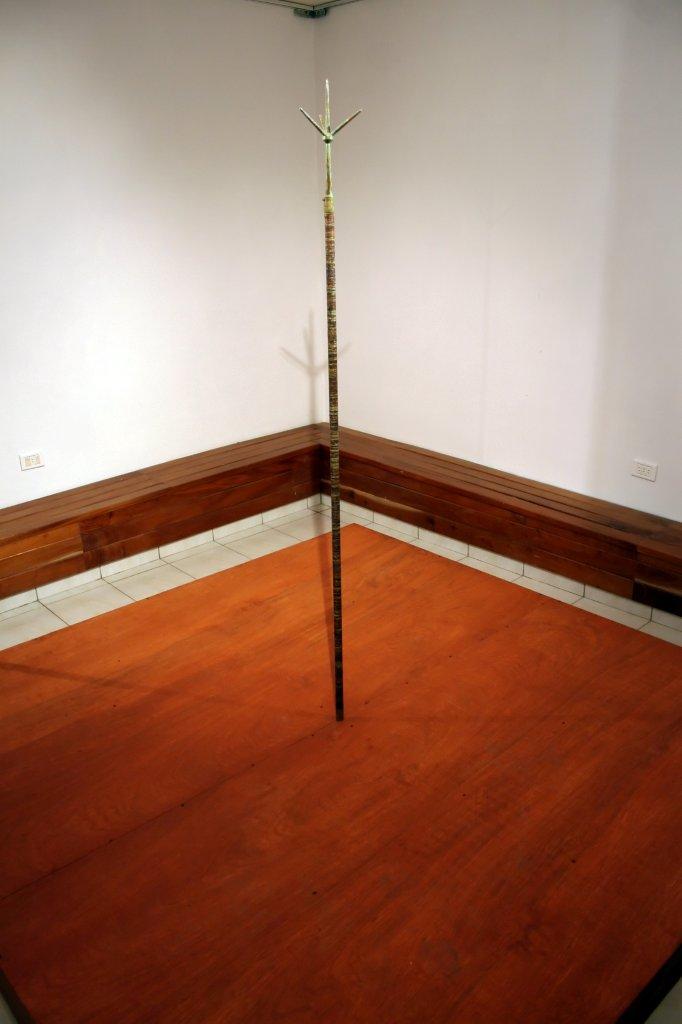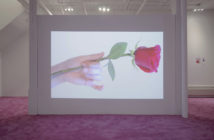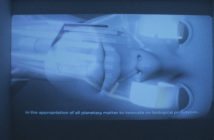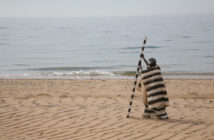Like most of America and the Caribbean, Cuba was brutally colonized by Europeans after Christopher Columbus landed on its shores in 1492. Cuba’s native population was decimated, and survivors melded with the conquering Spanish for the next several hundred years. Cuba gained independence in 1903, enduring more decades of political unrest and social upheaval when, in 1959, Fidel Castro led an uprising against the Cuban government. This history still quakes in contemporary Cuba, as each event has a particular aftermath perceptible in the nation’s identity. Taking his title from Gestos, the 1963 novel by Cuban artist and writer Severo Sarduy, curator Jorge Antonio Fernández Torres writes that Dilated Biography (on view at the SMFA through October 19) "may be understood as a series of small interceptions in a very wide creative universe." While our lives are brief, the magnitude of our actions, both personal and collective, reverberates throughout time.
The show is separated into two spaces, which serves to neatly divide the works into two poles: works that meditate on biography as internal versus external. Luis Gárciga’s video Destinos Posibles (Possible Destinations, 2009) is an appropriate place for the former category to start. Here, Havana cab passengers are offered a free ride to wherever they are going, so long as they answer two questions about their final destinations. With the camera focused on the faces of the passenger as they answer, displaying passing Havana scenery, Destinos Posibles records the emotional and material desires of each. One charge wants a VCR or DVD player, while another wants to have their child live with them. "I would like to have it all, but through my own effort," one says. A simple work, Destinos Posibles elegantly illustrates the essence of a ‘dilated biography.’ We circulate in the world, leaving a mark indelible or not, but leaving a mark nonetheless.
While Destinos Posibles ricochets throughout the space, two other videos, both installed towards the gallery’s back, dominate. These are Felipe Dulzaides’s Arriba de la Bola (On the Ball, 2000) and Grethell Rasúa’s Con su propio sabor (With Your Own Flavor, 2005-2006). Both are aggressive, and both exploit the repulsive-ness of the body.
 Felipe Dulzaides, Arriba de la Bola/On the Ball (still), 2000. Single channel video. 2 minutes 32 seconds. Courtesy the artist.
Felipe Dulzaides, Arriba de la Bola/On the Ball (still), 2000. Single channel video. 2 minutes 32 seconds. Courtesy the artist.In the first, Dulzaides stands square towards the camera, muttering and beat boxing, coming ever closer and closer to the camera’s lens. Finally, all we see is Dulzaides’s mouth against the camera, his figure completely distorted by the condensation of his breath against the lens, which his lips smudge as the work progresses. The figure ultimately retreats, but we can’t see him through the work of his breath. Nearby, Rasúa’s work depicts her asking for, and then receiving, the feces of her friends and family so she can grow a plant and sell it back to them. Casually requesting the excrement and explaining what she’ll do with it, Rasúa appears as if she might be asking a neighbor for sugar, or their wifi password. She collects the excrement in plastic shopping bags, and we see her carrying it through the street as she was carrying groceries. The video then presents the lush greenery yielded from a mixture of each person’s excrement and dirt, which Rasúa then harvests. The plants are cut for cooking, and the video ends with a close-up shot of the greens sizzling in a well-oiled frying pan. Con su propio sabor has an unpolished aesthetic that rhymes with the straightforward exchange of labor, product and money that’s depicted. People drive a country’s GDP, and Rasúa implores us to consider how uncivil—disgusting—profit before people can be. Further, Con su propio sabo disdains Castro's isolationism as well as the US-Cuba trade embargo. Together with Dulzaides’s work, Rasúa’s forcefully investigates how biography can inform and transform national or collective identity.
 Grethell Rasúa, Con Tu Propio Sabor/With Your Own Flavor (stills), 2005-06. Video documentation. Courtesy the artist.
Grethell Rasúa, Con Tu Propio Sabor/With Your Own Flavor (stills), 2005-06. Video documentation. Courtesy the artist.The works in the exhibition’s next room explore the inverse: that is, these works counter the idea that biography is shaped through the particularities of time, place and therefore politics. The works here exude a sense of threat, of persecution and resistance. Dennis Izquierdo’s Paranoia (2011) is appropriately stationed at this room’s entrance. A robotic object that takes its shape from sea urchins and missiles alike, Paranoia triggers the fear of attacking as well as being attacked. It’s as sharply hostile as Wilfredo Prieto’s nearby Politically Correct (2009), a cube of cut watermelon placed on the floor, is vulnerable. If identity is fueled by internal factors, external factors can lord over it, hovering just close enough to shape.
This room is also dominated by video work, though works by Roberto Diago, Diana Fonseca Quinones, Reinier Leyva Novo and Eduardo Ponjuán gracefully probe what it means to inhabit the world via your citizenship in a post-colonial country. Alexandre Arrechea’s White Corner (2006), in which two male figures, like twins, appear to blindly threaten and retreat from one another. One carries a bat, the other a baton-like weapon; one is dressed in boxers, the other blue jeans.
 Alexandre Arrechea, White Corner (still), 2006. Two video projections on two walls. 200 x 140 cm each side. Courtesy of the artist.
Alexandre Arrechea, White Corner (still), 2006. Two video projections on two walls. 200 x 140 cm each side. Courtesy of the artist.Both are anxious, sweating and breathing heavily, as they ready themselves to swing at each other. There is no perceptible sound in this work, but nearby, Javier Castro’s Negro sobre negro (Black on black, 2008), emits a subtle, wild noise. This video is thirty seconds long, but it’s arguable the most salient of this exhibition: in it, a black figure’s face approaches and recedes against a black backdrop, emerging and disappearing, the figure’s eyes and mouth defined, then obscured. A person is present and then becomes invisible. Does this figure exist if we can’t see him?
 Javier Castro, Negro sobre negro/Black on black (still), 2008. Video, color and sound, 30 seconds. Courtesy of the artist.
Javier Castro, Negro sobre negro/Black on black (still), 2008. Video, color and sound, 30 seconds. Courtesy of the artist."Historical commentaries are the result of the difficulty of assigning value to what we understand objectively," writes Torres in his statement. "Curatorial decisions are not to be regarded as attempts to make the exhibition more understandable — they coexist in a state of independence." Torres has successful assembled a complex sampling of the diverse, nuanced work that ambitiously challenges how personal and political identities are constructed, destroyed and remade on the Cuban island. Autobiography and biography are by definition conceptual—they are mere accounts of one life or another, told through individual biases. If everyone is an island unto ourselves, then our waves reverberate around our shores, eroding and molding with contact.





